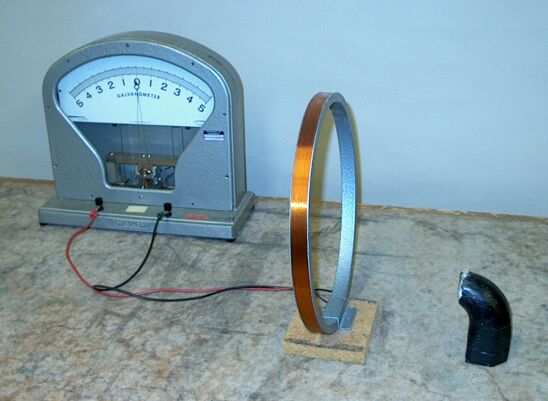
A wire coil is connected to a galvanometer. When you push a magnet toward the center of the coil, then pull it away, the galvanometer needle deflects in one direction, then the other. How far the needle deflects depends on the strength of the magnet, how far you hold it from the coil, and how fast you move it.
This demonstration is an illustration of Faraday’s law of induction, which states that a changing magnetic flux induces an electromotive force, or emf, in a loop of wire, or E = -dΦB/dt. (The full-blown law is ∮E·dl = -dΦB/dt.) This emf then pushes a current through the loop. Even though it is the induced emf that is responsible for the current, it is not uncommon for people to speak of the current as being induced by the changing magnetic flux, as a kind of shorthand. For a coil wound so that the turns are close to each other, the change in flux through each turn is the same, and an emf appears across each turn. Thus, for a coil of N turns, the emf across the whole coil is E = -NdΦB/dt.
This also demonstrates Lenz’s law, which states that the current produced by the induced emf flows in the direction that opposes the change in flux that induced the emf. This is implied by the minus sign in Faraday’s law. If you bring the north end of the magnet toward the coil, the induced emf produces a current whose associated magnetic field has its north end pointing toward the magnet. (See demonstrations 68.13 -- Right-hand rule model, and 68.46 -- Magnetic fields of coils.) If you pull the north end away from the coil, the current flows in the opposite direction, so that the associated magnetic field points with its south pole toward the magnet. Similarly, if you flip the magnet to bring its south pole toward the coil, the current flows in the direction that produces a magnetic field whose south pole faces the magnet, and if you pull the magnet away, it reverses so that the north pole faces the magnet. How fast you move the magnet determines the rate of change of the magnetic flux, so the faster you move the magnet, the greater the needle deflection.
The magnetic flux through a surface is ΦB = ∫B · dS. If the magnetic field, B, is uniform and perpendicular to the surface, and the surface is finite, then ΦB = BA, where A is the area of the surface. In this demonstration, A is the area of the coil. The SI unit of magnetic field is the tesla, which equals 1 N/A·m. 1 tesla also equals 1 weber/meter2. The weber, which also equals 1 V·s (= 1 N·m/A, or 1 kg·m2/A·s2), is the SI unit of magnetic flux. In this demonstration, it is the change in magnetic flux, dΦB/dt, that is important. As long as the magnet and coil are not moving with respect to each other, there is no induced emf in the coil, and thus no current, and no galvanometer needle deflection.
Which way the galvanometer needle deflects depends on which side of the coil faces the magnet as you are moving it. The coils are marked to show which end goes to the red wire and which end goes to the black wire, so that if you wish, you can predict the direction in which the needle will deflect as you move the magnet.
It does not matter, of course, whether you keep the coil stationary and move the magnet, or keep the magnet stationary and move the coil. What is important is their motion relative to each other, which is what determines the change in magnetic flux through the coil.
References:
1) Halliday, David and Resnick, Robert. Physics, Part Two, Third Edition (New York: John Wiley and Sons, 1978), pp.720, 770-774, 886.
2) Sears, Francis Weston and Zemansky, Mark W. College Physics, Third Edition (Reading, Massachussetts: Addison-Wesley Publishing Company, Inc., 1960), p. 612.